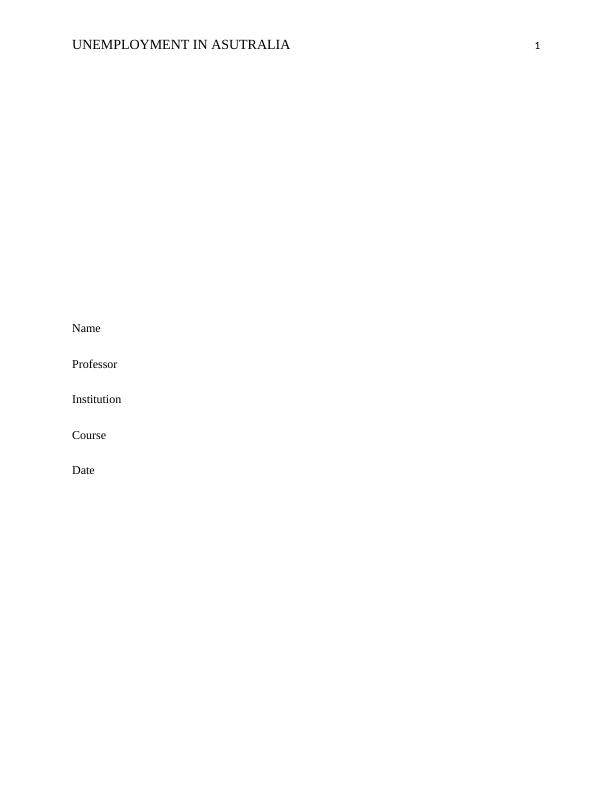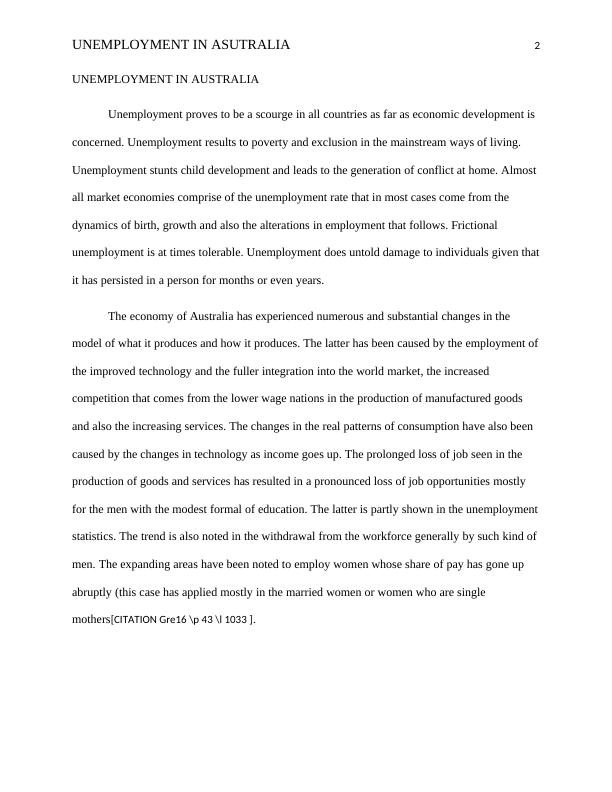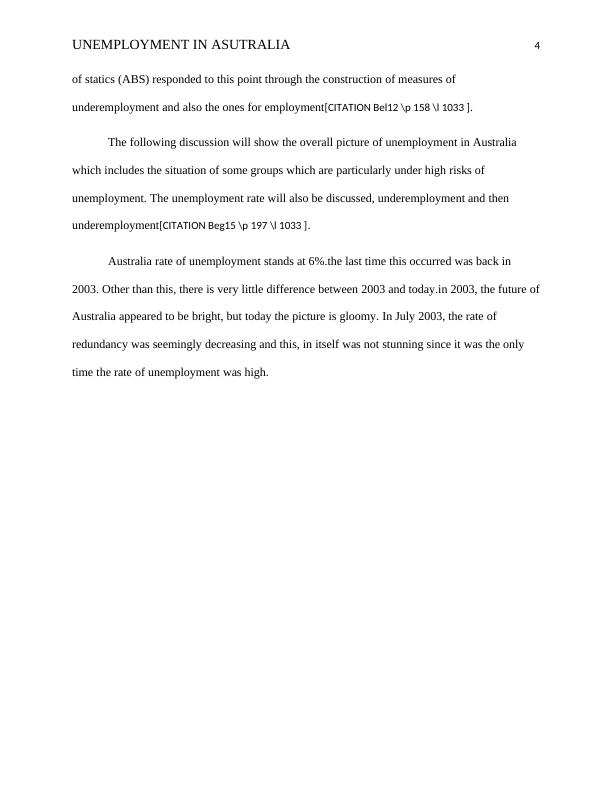Unemployment in Australia: Causes, Effects and Government Policies
Added on 2023-06-04
13 Pages3304 Words69 Views
UNEMPLOYMENT IN ASUTRALIA 1
Name
Professor
Institution
Course
Date
Name
Professor
Institution
Course
Date

UNEMPLOYMENT IN ASUTRALIA 2
UNEMPLOYMENT IN AUSTRALIA
Unemployment proves to be a scourge in all countries as far as economic development is
concerned. Unemployment results to poverty and exclusion in the mainstream ways of living.
Unemployment stunts child development and leads to the generation of conflict at home. Almost
all market economies comprise of the unemployment rate that in most cases come from the
dynamics of birth, growth and also the alterations in employment that follows. Frictional
unemployment is at times tolerable. Unemployment does untold damage to individuals given that
it has persisted in a person for months or even years.
The economy of Australia has experienced numerous and substantial changes in the
model of what it produces and how it produces. The latter has been caused by the employment of
the improved technology and the fuller integration into the world market, the increased
competition that comes from the lower wage nations in the production of manufactured goods
and also the increasing services. The changes in the real patterns of consumption have also been
caused by the changes in technology as income goes up. The prolonged loss of job seen in the
production of goods and services has resulted in a pronounced loss of job opportunities mostly
for the men with the modest formal of education. The latter is partly shown in the unemployment
statistics. The trend is also noted in the withdrawal from the workforce generally by such kind of
men. The expanding areas have been noted to employ women whose share of pay has gone up
abruptly (this case has applied mostly in the married women or women who are single mothers
(Gregory, 2016, p. 43).
UNEMPLOYMENT IN AUSTRALIA
Unemployment proves to be a scourge in all countries as far as economic development is
concerned. Unemployment results to poverty and exclusion in the mainstream ways of living.
Unemployment stunts child development and leads to the generation of conflict at home. Almost
all market economies comprise of the unemployment rate that in most cases come from the
dynamics of birth, growth and also the alterations in employment that follows. Frictional
unemployment is at times tolerable. Unemployment does untold damage to individuals given that
it has persisted in a person for months or even years.
The economy of Australia has experienced numerous and substantial changes in the
model of what it produces and how it produces. The latter has been caused by the employment of
the improved technology and the fuller integration into the world market, the increased
competition that comes from the lower wage nations in the production of manufactured goods
and also the increasing services. The changes in the real patterns of consumption have also been
caused by the changes in technology as income goes up. The prolonged loss of job seen in the
production of goods and services has resulted in a pronounced loss of job opportunities mostly
for the men with the modest formal of education. The latter is partly shown in the unemployment
statistics. The trend is also noted in the withdrawal from the workforce generally by such kind of
men. The expanding areas have been noted to employ women whose share of pay has gone up
abruptly (this case has applied mostly in the married women or women who are single mothers
(Gregory, 2016, p. 43).

UNEMPLOYMENT IN ASUTRALIA 3
In the Australian experience, the rate of unemployment has been nagging and also very
intense for the last almost two decades. However, sustained expansion in the economy over the
previous ten years has led to the reduction of the existing level of unemployment to relatively
low levels (Hugo, 2015, p. 247). The advantages of reducing levels of unemployment are evident
even in the most problematic sectors like the rate of unemployment in youth, the issues to do
with long-term unemployment and the low rate of employment in the older people.
The issue of joblessness is not just a defined model. This attests to be real even in nation
like Australia whereby the manufacture of goods takes place in a formal economy and whereby
most of the individuals there toil for remunerations. In Australia, the standard normal definition
for unemployment is done: people are said to be jobless if they did not grind for at least one hour
in the preceding week, people were aggressively searching for a job and managed to receive a
contract in the following week if at all it were available. This definition makes it impressing.
Through a phone call, people are asked whether they worked for at least an hour in the previous
week (Burgess , & Mitchell, 2013, p. 153). The people who worked in the so-called black
economy will not respond to the question truthfully.
The people who want to work but have given up in the zeal to look for jobs are not
included in the unemployment. The latter gives the government a good opportunity to measure
the level of unemployment through the provision of small welfare payment that in the long run
takes people out of their workforce. A person is said to be employed if he worked for at least an
hour in the previous week. The latter definition shows a big difference between people who
worked for just a single hour as compared to another person who worked for almost 40 hours a
week as both with have a difference both concerning income and effort. The Australian Bureau
In the Australian experience, the rate of unemployment has been nagging and also very
intense for the last almost two decades. However, sustained expansion in the economy over the
previous ten years has led to the reduction of the existing level of unemployment to relatively
low levels (Hugo, 2015, p. 247). The advantages of reducing levels of unemployment are evident
even in the most problematic sectors like the rate of unemployment in youth, the issues to do
with long-term unemployment and the low rate of employment in the older people.
The issue of joblessness is not just a defined model. This attests to be real even in nation
like Australia whereby the manufacture of goods takes place in a formal economy and whereby
most of the individuals there toil for remunerations. In Australia, the standard normal definition
for unemployment is done: people are said to be jobless if they did not grind for at least one hour
in the preceding week, people were aggressively searching for a job and managed to receive a
contract in the following week if at all it were available. This definition makes it impressing.
Through a phone call, people are asked whether they worked for at least an hour in the previous
week (Burgess , & Mitchell, 2013, p. 153). The people who worked in the so-called black
economy will not respond to the question truthfully.
The people who want to work but have given up in the zeal to look for jobs are not
included in the unemployment. The latter gives the government a good opportunity to measure
the level of unemployment through the provision of small welfare payment that in the long run
takes people out of their workforce. A person is said to be employed if he worked for at least an
hour in the previous week. The latter definition shows a big difference between people who
worked for just a single hour as compared to another person who worked for almost 40 hours a
week as both with have a difference both concerning income and effort. The Australian Bureau

UNEMPLOYMENT IN ASUTRALIA 4
of statics (ABS) responded to this point through the construction of measures of
underemployment and also the ones for employment (Bell, 2012, p. 158).
The following discussion will show the overall picture of unemployment in Australia
which includes the situation of some groups which are particularly under high risks of
unemployment. The unemployment rate will also be discussed, underemployment and then
underemployment (Beggs & Chapman, 2015, p. 197).
Australia rate of unemployment stands at 6%.the last time this occurred was back in
2003. Other than this, there is very little difference between 2003 and today.in 2003, the future of
Australia appeared to be bright, but today the picture is gloomy. In July 2003, the rate of
redundancy was seemingly decreasing and this, in itself was not stunning since it was the only
time the rate of unemployment was high.
(Hugo, 2015, p. 342).
of statics (ABS) responded to this point through the construction of measures of
underemployment and also the ones for employment (Bell, 2012, p. 158).
The following discussion will show the overall picture of unemployment in Australia
which includes the situation of some groups which are particularly under high risks of
unemployment. The unemployment rate will also be discussed, underemployment and then
underemployment (Beggs & Chapman, 2015, p. 197).
Australia rate of unemployment stands at 6%.the last time this occurred was back in
2003. Other than this, there is very little difference between 2003 and today.in 2003, the future of
Australia appeared to be bright, but today the picture is gloomy. In July 2003, the rate of
redundancy was seemingly decreasing and this, in itself was not stunning since it was the only
time the rate of unemployment was high.
(Hugo, 2015, p. 342).

End of preview
Want to access all the pages? Upload your documents or become a member.
Related Documents
HI5002 - Unemployment issue in Australia - Research Paperlg...
|10
|3064
|42
Economics for Business pdflg...
|15
|3564
|47
Unemployment in Australia: Effects on the Economy and Government Policieslg...
|15
|3581
|422
Unemployment Rate in Australialg...
|11
|3342
|306
Australia's Unemployment (pdf)lg...
|15
|3557
|37
Unemployment in Australia Reportlg...
|14
|3360
|80
